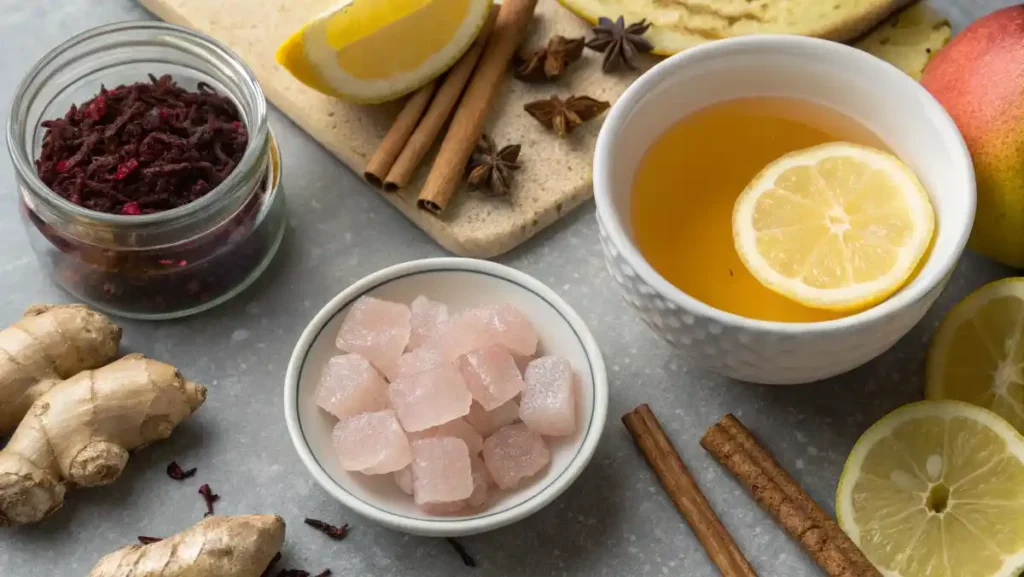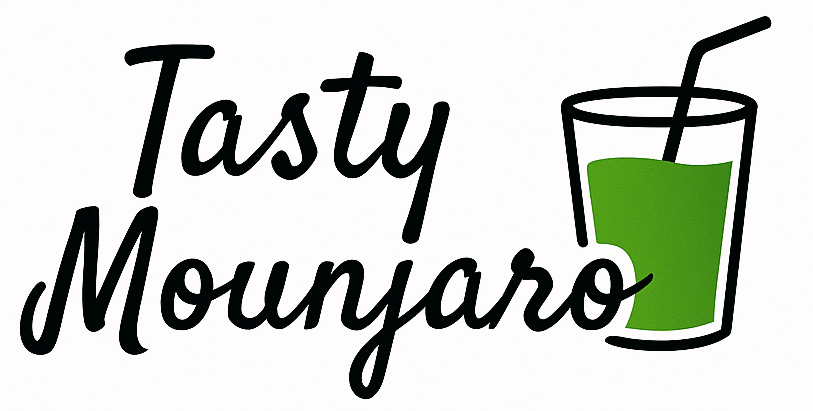In 2025, wellness conversations are shifting away from pills and powders toward natural weight loss drinks that support the body with real ingredients. Leading the charge are two standout blends: the Zepbound drink reset and the Japanese Mounjaro drink. Both are simple, homemade beverages that promise digestive support, better energy, and potential weight management—but which one truly delivers?

This article explores the growing buzz around Zepbound vs Japanese Mounjaro, comparing their key ingredients, claimed benefits, and how they stack up in daily life. Whether you’re curious about apple cider vinegar drink benefits or intrigued by a konjac jelly drink for weight loss, this breakdown helps you discover which option may be the best healthy drink for digestion and balance.
Print
Japanese Mounjaro: Which Wellness Drink Wins in 2025?
- Total Time: 10 minutes
- Yield: 1 serving
Description
This Japanese-inspired wellness drink blends konjac jelly, brewed tea, citrus, ginger, and umeboshi for a gut-friendly, fiber-rich refreshment that supports digestion and sustained fullness.
Ingredients
Green or oolong tea – 1 cup, brewed and chilled
Konjac jelly (glucomannan) – 2 tbsp
Citrus juice (yuzu or lemon) – 1 tbsp
Pickled umeboshi plum – 1/2 (mashed)
Fresh ginger – 1/2 tsp
Instructions
1. Brew the tea and let it cool completely.
2. In a glass, mash the umeboshi plum until soft.
3. Stir in citrus juice and ginger.
4. Add konjac jelly and pour the chilled tea over.
5. Mix gently and serve cold.
Notes
To make konjac jelly from powder, follow package instructions and chill before using.
For a sweeter version, add a few drops of monk fruit or stevia.
- Prep Time: 10 minutes
- Cook Time: 0 minutes
- Category: Wellness Drinks
- Method: No-Cook
- Cuisine: Japanese-Inspired

Zepbound Drink: Which Wellness Drink Wins in 2025?
- Total Time: 3 minutes
- Yield: 1 serving
Description
The Zepbound drink reset is a bold morning blend made with apple cider vinegar, lemon, ginger, and salt. Designed to kickstart digestion and energy naturally — no caffeine, no gimmicks.
Ingredients
Filtered water – 1 cup
Lemon juice – 1 tbsp
Raw apple cider vinegar – 1 tbsp
Fresh ginger, grated – 1 tsp
Cinnamon – 1/4 tsp
Pink Himalayan salt – pinch
Instructions
1. In a glass, combine the filtered water, lemon juice, and apple cider vinegar.
2. Add grated ginger, cinnamon, and salt.
3. Stir well and drink cold or room temperature.
4. Enjoy first thing in the morning before eating.
Notes
You can prepare this the night before and store it in the fridge for up to 3 days.
If the taste is too strong, add an extra 1/4 cup of water or a few drops of stevia.
- Prep Time: 3 minutes
- Cook Time: 0 minutes
- Category: Wellness Drinks
- Method: No-Cook
- Cuisine: Detox
Table of Contents
The Story Behind the Trend and Why It Matters
Why I’m Exploring These Natural Wellness Drinks
I’m Ramsay — an engineer by trade, but lately, a student of wellness. After years spent behind monitors and late-night deadlines, my health started lagging behind my ambitions. Low energy, brain fog, and constant cravings became the norm. I didn’t want a medical overhaul — I wanted something clean, manageable, and real.
That’s how I started noticing a trend in natural weight loss drinks — simple, daily blends made with real ingredients, meant to help the body reset. Two in particular kept surfacing in my research: the Zepbound drink reset and the Japanese Mounjaro drink. They weren’t hyped supplements or medications. They were functional, food-based drinks. That caught my attention.
This article isn’t based on personal trials — it’s about curiosity and discovery. I’ve taken a deep dive into what these drinks are, how they work, and which one might support your wellness goals best. If you’re exploring konjac jelly drinks for weight loss or want to better understand apple cider vinegar drink benefits, you’re in the right place.
To dig into the traditional side of things, you can also read my guide on the Japanese Mounjaro drink, which explains how it works and why it’s gaining attention in 2025.
Zepbound vs Japanese Mounjaro: Not Just Drinks, But Two Approaches to Health
At a glance, both drinks seem similar — simple ingredients, easy to prepare, and geared toward gut health. But their foundations are quite different.
The Zepbound drink reset draws inspiration from metabolic-focused protocols. It blends ingredients like apple cider vinegar, ginger, lemon juice, pink Himalayan salt, and cinnamon — all chosen for their role in digestion, hydration, and cleansing. It’s designed to be quick, efficient, and energizing, especially when taken first thing in the morning.
On the other hand, the Japanese Mounjaro drink has roots in mindful eating. It uses a base of green or oolong tea, citrus, ginger, and a uniquely Japanese twist: konjac jelly, a natural fiber known for promoting fullness. The drink also often includes umeboshi, a fermented plum that supports digestion and balances flavor. It’s less about the reset, and more about steady support — ideal for sustained energy and mindful routines.
If you’re leaning toward metabolic hydration, here’s how to prepare the Zepbound drink using ingredients you already have in your pantry.
How the Ingredients Compare — Simplified Breakdown

To understand how each drink functions, it helps to compare them side by side. Here’s a breakdown of the core elements:
| Ingredient Type | Zepbound Drink Reset | Japanese Mounjaro Drink |
|---|---|---|
| Liquid Base | Filtered Water + Pink Salt | Green or Oolong Tea |
| Functional Add-ins | Lemon Juice, Ginger, Cinnamon | Citrus, Ginger, Umeboshi |
| Star Ingredient | Raw Apple Cider Vinegar | Konjac Jelly (Glucomannan) |
Here’s the key difference: Zepbound works as a fast-acting reset to support digestion and energy from the start of your day. The Japanese Mounjaro drink, meanwhile, offers a slower-release effect — helping you feel fuller longer while gently nourishing your gut. If you’re someone looking to add a homemade Mounjaro drink recipe into your lifestyle for daily balance, this might be the option that aligns better with your routine.
Benefits Breakdown — Side-by-Side Comparison
Which Drink Supports Natural Weight Loss Best?
When it comes to functional beverages, one of the biggest questions people ask is: Will this actually help with weight loss? The short answer? It depends on what your body needs — and how each drink works with your lifestyle.
The Zepbound drink reset is often used as part of a daily morning routine. Thanks to its blend of lemon juice, ginger, apple cider vinegar, pink salt, and cinnamon, it supports digestion, may improve insulin sensitivity, and helps reduce water retention. These benefits can contribute to a flatter belly and improved energy. Additionally, apple cider vinegar drink benefits are well-documented for regulating appetite and improving gut health.
The Japanese Mounjaro drink, meanwhile, takes a more fiber-forward approach. Its standout ingredient — konjac jelly (also called glucomannan) — is a natural soluble fiber that expands in the stomach and slows digestion. This helps you feel fuller longer, which can reduce snacking and support caloric control throughout the day. Combined with bitter tea tannins and umeboshi, it promotes gentle cleansing and satiety.
Both are excellent natural weight loss drinks for 2025, but they work in different ways:
Zepbound activates quickly and helps your body reset in the short term, while Japanese Mounjaro encourages slower digestion and long-term appetite control.
👉 Want to see how konjac works in action? Learn more in the detailed Japanese Mounjaro drink breakdown, where konjac jelly plays a key role in fullness and fiber.
Digestion, Energy & Gut Health — Who Has the Edge?
Aside from weight management, these drinks also differ in how they support digestion and overall energy.
The Zepbound drink reset offers fast digestive support. Lemon and ginger stimulate bile and stomach acid, which can help your body break down food more efficiently. The addition of pink Himalayan salt provides trace minerals and electrolytes, helping hydrate and rebalance first thing in the morning. That combination delivers a quick, clean energy boost — without caffeine or sugar.
In contrast, the Japanese Mounjaro drink supports digestion by promoting a calmer, more gradual flow of food through the system. Green or oolong tea contains antioxidants and mild caffeine, while umeboshi helps combat acidity and ease bloating. Konjac acts like a sponge, absorbing water and slowing gastric emptying — which means longer-lasting energy and fewer sugar crashes.
If you struggle with sluggish digestion, low energy, or afternoon crashes, either drink can help. But the approach matters: Zepbound is ideal for a morning kickstart, while Japanese Mounjaro helps maintain steady energy and digestive balance all day.
👉 Looking for other healthy drink options for digestion? Explore our collection of functional drinks in the natural reset category for blends that support energy and gut health naturally.
Taste, Lifestyle Fit & Ease of Use
Which One Tastes Better — And Can You Stick With It?
When building a wellness habit, flavor isn’t just a bonus — it’s a dealbreaker. No one wants to sip something every day that feels like a chore.
The Zepbound drink reset delivers a bold, invigorating flavor. The mix of lemon and apple cider vinegar is sharp and citrusy, while ginger and cinnamon bring warmth and spice. The touch of pink Himalayan salt rounds it out with a subtle mineral edge. It’s not sweet — and definitely not subtle — but it leaves a clean finish that many find refreshing first thing in the morning.
In contrast, the Japanese Mounjaro drink has a milder, earthier taste. It starts with green or oolong tea, which gives it a smooth, slightly bitter foundation. That’s enhanced with ginger and citrus, and softened by the tangy depth of umeboshi. When konjac jelly is added, the drink gains a thicker, almost smoothie-like consistency that feels more substantial — especially chilled.
If your palate prefers bold and energizing, Zepbound might be your go-to. If you want something gentle, balanced, and easy to sip slowly, Japanese Mounjaro offers a more calming experience.
👉 For ideas on how to tailor the flavor to your taste, check out this fully customizable homemade Mounjaro drink recipe.
Which One Works in Real Life — Busy Mornings or Midday Routines?
Taste matters — but daily fit might matter more. The easier a drink is to prep and enjoy, the more likely it is to become a lasting part of your routine.
Zepbound wins on simplicity. You combine the ingredients — lemon juice, raw apple cider vinegar, ginger, cinnamon, salt, and water — and stir. Most people drink it right after waking up as part of a hydration-first routine. There’s no brewing or chilling required. You can even prep a few servings in advance and store them in the fridge, making it the perfect grab-and-go reset.
Japanese Mounjaro, while a little more involved, offers flexibility. Brewing tea and preparing konjac jelly might take an extra 10 minutes, but many people batch a full day’s worth at once. This drink fits well in the afternoon — especially if you’re looking to curb hunger between meals or support digestion after lunch. Its cooling nature also makes it ideal for warm weather or relaxed evening rituals.
In short: Zepbound works best for structured, fast-paced mornings, while Japanese Mounjaro pairs well with slower, nourishing routines.
👉 Want tips on how to build a morning reset ritual with Zepbound? Explore this easy prep guide for Zepbound drink reset and simplify your start to the day.
Final Verdict: What’s Healthier in 2025?
What Your Body Needs Might Be Different from What’s Trending
When it comes to choosing between the Zepbound drink reset and the Japanese Mounjaro drink, there’s no one-size-fits-all answer. They’re both made from real, accessible ingredients. They both support digestion, hydration, and energy in different ways. And in a world that’s moving away from processed quick-fixes, that’s already a big win.
But here’s where they differ — and where your choice becomes personal.
If your priority is a quick, refreshing reset that fits neatly into a fast-paced routine, Zepbound might be your perfect morning ritual. Its acidic profile and energizing spice combo make it ideal for those who want to kickstart digestion and metabolism right out of the gate. It’s also simpler to prep daily, and works great as part of an intermittent fasting or detox-style routine.
On the flip side, if you’re leaning toward longer-term balance, gut health, and gentle satiety, the Japanese Mounjaro drink may serve you better. Its base of antioxidant-rich tea, fiber-packed konjac jelly, and fermented plum supports smoother digestion and sustained fullness — which can make it easier to reduce cravings, especially when paired with whole foods.
👉 If you’re starting your wellness reset and unsure where to begin, take a deeper look at the natural Mounjaro drink approach — especially if you prefer fiber and tea-based drinks that feel like part of a mindful lifestyle.
So — Zepbound or Japanese Mounjaro?
Here’s a quick breakdown to help you decide:
| Choose Zepbound If You Want… | Choose Japanese Mounjaro If You Want… |
|---|---|
| A quick daily reset | A slow, steady digestive rhythm |
| A bold, energizing taste | A calming, tea-like flavor |
| Minimal prep time | More fiber and satiety |
| High flavor intensity | Balanced, mild ingredients |
In the end, it’s less about which drink is “better” — and more about what fits your body, your schedule, and your goals in this season of life.
If you’re ready to get started, explore the Zepbound reset drink recipe or try the Japanese Mounjaro blend — and let your next step be one you can actually enjoy.
Conclusion: Choose the Drink That Supports Your Goals
In the wellness space, it’s easy to get lost in trends and claims. But when it comes to Zepbound vs Japanese Mounjaro, the difference isn’t hype — it’s how each drink supports your body in a different way.
Zepbound is ideal for fast routines, quick digestive resets, and a bold kick to your morning. It’s efficient, energizing, and built around ingredients like apple cider vinegar, lemon, ginger, and pink salt.
Japanese Mounjaro, on the other hand, offers a gentle, mindful approach. With konjac jelly, brewed tea, citrus, and umeboshi, it supports satiety, gut health, and long-term balance — making it a standout among natural weight loss drinks in 2025.
Whichever you choose, remember: it’s not about doing everything. It’s about starting with one small, supportive step that helps you feel better every day.
So take a sip, tune into what your body’s asking for, and keep going. You’ve got options — and now you know how to choose them wisely.
For more recipes, follow me on Facebook & Pinterest.
FAQs — Zepbound vs Japanese Mounjaro
What is the difference between Zepbound and Japanese Mounjaro drinks?
Zepbound is a modern reset drink that uses apple cider vinegar, ginger, lemon, and pink salt to support digestion and metabolism. It’s typically used in the morning to energize and reset. The Japanese Mounjaro drink, however, leans into slow-digesting ingredients like konjac jelly, brewed tea, and umeboshi, promoting gentle fullness and gut health throughout the day.
Is the Japanese Mounjaro drink good for weight loss?
Yes, thanks to its high soluble fiber content from konjac jelly (glucomannan), the Japanese Mounjaro drink helps increase satiety, reduce cravings, and support calorie control. It’s a great option for those interested in natural weight loss drinks that don’t rely on stimulants or synthetic ingredients.
Can I drink Zepbound every day?
Yes — many people include the Zepbound drink reset as a daily hydration ritual, especially in the morning. It’s quick to prepare and contains ingredients like apple cider vinegar and lemon, which may help support digestion and reduce bloating. However, if you’re sensitive to acidic ingredients, it’s best to monitor how your body reacts.
Which one is better for digestion — Zepbound or Japanese Mounjaro?
Both support digestion but in different ways. Zepbound stimulates digestive enzymes and bile flow for quick relief, while Japanese Mounjaro slows digestion and promotes long-term gut balance through tea, fiber, and fermented foods. Your choice depends on whether you want fast relief or gentle, sustained support.
